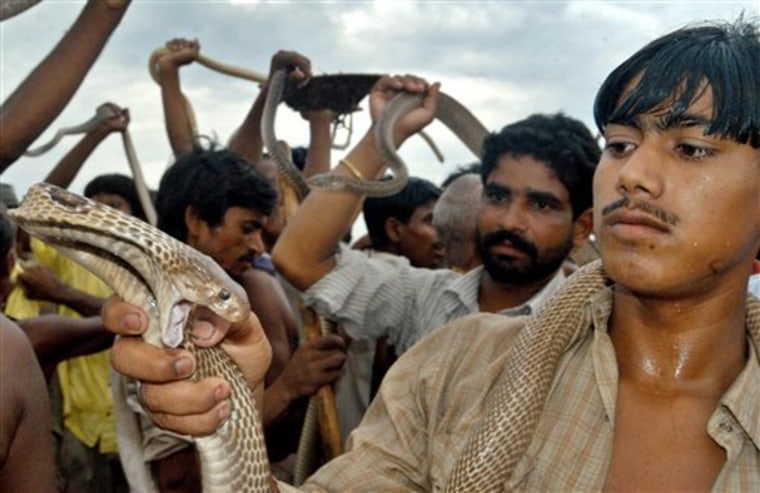South Asia's annual monsoon often seems like a calamity of Old Testament proportions — people are drowned in raging flood waters, crushed by collapsing buildings, wasted by plagues and struck down by snakes.
Yes, snakes.
The monsoon rains that flood wide stretches of the subcontinent each year force creatures large and small, harmless and deadly, onto whatever dry land can be found, and the result is scores, if not hundreds, of fatal snake bites.
"Everything, everyone, is restricted to tiny, tiny islands with very little space," said Romulus Whitaker, a snake expert. "Everyone is crammed in together and the chances of running into snakes, stepping on them, grabbing them and sleeping on them is much, much more."
So tight is the association of snakes with the annual rains — which are needed to water farms that provide a livelihood for two-thirds of India's 1.1 billion people — that the serpents have for millennia been revered as well as feared across much of the subcontinent.
With this year's monsoon particularly calamitous — at least 2,090 people have been killed across South Asia and 19 million forced from their homes — tales of snake bites abound, from the farming villages along the banks of Ganges River to the valleys of India's remote northeast.
"These serpents even climb up the trees. They are as nervous and scared as human beings and they bite only if they are disturbed," said Vinod Chaudhry, a government wildlife expert.
Cautionary tale
That's how Paltu Ram, a farmer in his 20s, died.
Stranded with a few hundred villagers on a sliver of land encircled by flood waters in the Bara Banki district of northern India, about 370 miles east of New Delhi, he decided to climb a tree to see if he could spot a rescue boat.
On his way up, he reached for what looked like a brown rope. It wasn't and when he grabbed it, the snake recoiled and then struck, sinking its fangs into his arm.
"Paltu jumped into water saying he was bitten by snake. Before he could be taken to a doctor he died," said his father, Rameshwar, who couldn't say what kind of snake got his son.
Officials in India don't keep exact figures for the number of snake bites during the monsoon, and experts say even annual totals are considered unreliable.
But in one indication of how many monsoon deaths are caused by snakes, Bangladesh's government said Thursday at least 35 of the 226 people killed in this year's monsoon died from being bitten by the creatures, the second-highest cause of death after drowning.
There are hundreds of different snakes on the subcontinent, many of which are venomous. But only four are responsible for the vast majority of deaths — kraits, russell's vipers, saw-scaled vipers and cobras.
Weather, farming symbols
All are extremely dangerous — and all are venerated.
The appearance of those snakes, especially cobras, has long been viewed as a harbinger of coming floods and the renewed fertility that follows. Their disappearance is taken as an omen of a coming drought.
In some parts of India, it is also believed snakes can cause plagues by blowing their breath across the land, and malaria is known as snake-wind disease.
Hindu gods are often depicted with cobras: Shiva is seen wearing a girdle of serpents and cobras for earrings; Vishu is pictured resting on the coils of a multi-headed cobra.
In India and Nepal, where authorities say a handful of the 92 people killed by this year's monsoon died from snake bites, there is even a special holiday to worship the serpents.
Some Buddhist legends have also incorporated snakes, such as the tale of the giant cobra that used its hood to shield Buddha from the sun as he mediated in the desert.
There are no hard figures for the exact density of snakes on the subcontinent, but anecdotal evidence suggest it's high. Whitaker said the tribal hunters he works with can pull two or three cobras from a 5-acre rice paddy in a day. "That's a lot of snakes from a small patch."
Rats, frogs attract snakes
The reason there are so many is the small farms that still cover much of rural India provide the perfect habitat for snakes' prey, such as rats or frogs.
"Plenty of water in irrigated rice fields; there are places in the country where rats are worshipped so they don't kill them."
The good news is that it usually takes hours or sometimes days for a snake bite to kill, and that only 10-20 percent of such attacks are fatal, depending on who you ask.
Of course, that's little comfort to the many people who have to walk for days to get to hospitals — or those who decide to go to a traditional healer before getting the anti-venom.
Rahmat Mia, 45, a farmer, in northern Bangladesh was bitten a few nights ago while returning from a market.
His family first took him to a healer, and stayed for hours trying out various herbal remedies.
By the time Babul Hossain, the local doctor, convinced them to go to the hospital, it was too late — Mia died on the way.
